Reasons why babies neglect one arm and hand
There are two main reasons why an infant has difficulties with moving one arm. The first is Erb's Palsy, an injury to the nerves going to the arm that occurs during birth. Because the baby does not move the arm at all, the injury is usually picked up early and the baby is referred to a specialist doctor for assessment and referral to physical therapy. Read more
The other reason for weakness and neglect of one arm is damage to the developing brain, either before or at birth. A disturbance in development of the brain may be associated with preterm birth. Full term infants may suffer a perinatal stroke before or just after birth. A perinatal stroke causes neglect and weakness in the arm and leg on the one side, and is often missed because the signs and symptoms may be very subtle in the young baby, but become more prominent over time.
|
Early diagnosis of cerebral palsy Historically, the diagnosis of cerebral palsy (CP) was made between age 12 and 24 months when movement dysfunction was clearly apparent. At the same time the prevailing attitude to early parental concerns was a "wait and see" and intervention was delayed until a diagnosis had been made. However in 2017 a systematic review of the literature showing that a diagnosis of cerebral palsy can be accurately made before 6 months’ corrected age was published. This review showed that early diagnosis can be made using a combination of standardized tools along with clinical history. These tools include magnetic resonance imaging, the Prechtl Qualitative Assessment of General Movements and the Hammersmith Infant Neurological Examination. It is important to recognize that in 50% of all infants with cerebral palsy, the pregnancy and labor may have appeared to be uneventful. It is only when the infant's motor milestones are delayed, especially sitting, standing, and using the two hands together to manipulate objects that parents and health care professionals became concerned that the possibility of a CP diagnosis is considered. This finding may be especially true for infants with unilateral cerebral palsy, who often master early rudimentary motor skills, such as smiling, swallowing, and head control, and it is not until they attempt more complex motor skills, such as sitting, standing and bilateral grasp, that asymmetries become observable. |
Knowing how babies move their arms is the first step to recognizing possible neglect.
If you notice that your baby is not using the one hand in the same way as the other one, it is a good idea to take some time to observe how your baby uses their hands for different activities.
Then, if you still have concerns that your baby is neglecting the one hand, and the abilities of one do not match those of the other hand, it is a good idea to ask your child's primary health care professional to assess your baby's motor development and make a referral to a pediatrician or early intervention occupational or physical therapist for a full assessment.
Very young babies: 1-2 months
At this age babies often lie with their heads turned to one side, with one arm straight and the other one bent. Most babies have a preferred side for turning the head.
In this position the baby will often spend time looking at her hand with great interest.

Very young babies, when they are awake and alert, will engage in bouts of vigorous moving of the arms and the legs. The amount and pattern of the movements are the similar for the right and the left arm and leg.
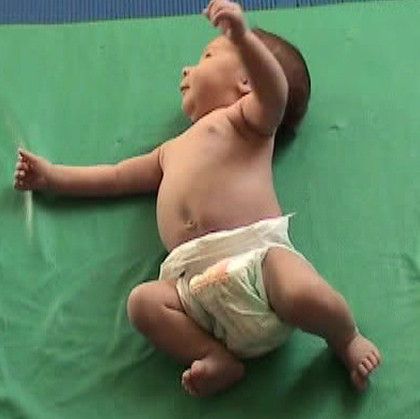
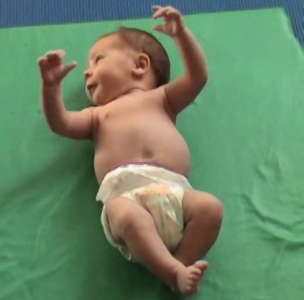
If you hang a toys within easy reach, young babies will start to make swiping movements of the arm in the direction of the toy.

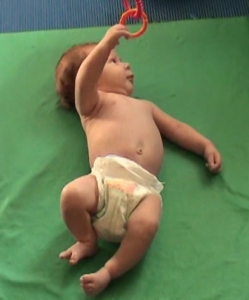
At this age babies tend to hold their hands lightly fisted with the thumb next to the index finger most of the time. But they will also open and close the fingers, and will move the fingers separately, pointing with one finger or bringing the tip of the thumb and forefinger together.
Babies from 3-6 months
At this age babies have learned to lie with their heads straight and bring their hands together in the midline above the face where they are a good position for easy, intense visual inspection.

Babies like to feel one hand with the other using complex finger movements and will watch these actions with great interest.

In this position babies will start to hold a toy with one hand and use the fingers of the other hand to inspect the toy.
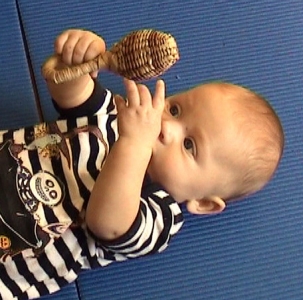
They also use their hands and fingers to explore any surface they touch including clothing and their own bodies.

At 3 months babies will keep holding a toy that is placed in the hand for a short period of time. By 4 months babies will hold the toy and take time to look at it carefully. .

At this age babies will usually reach for a toy that is presented in within easy reaching distance, with both hands.
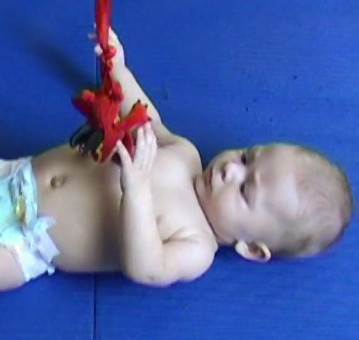
Read more:
Encouraging your baby to use their hands
Tracking your baby's progress Early action - lying, kicking, rolling and reaching
Babies 7-8 months and older
From 7-8 months typically developing babies have started to use their arms to move around on their tummies by scooting backwards, commando crawling and getting up onto all fours.
Babies with weakness in the one arm find it difficult to push up into the crawling position and will often opt for commando crawling using the stronger arm to propel themselves forwards.
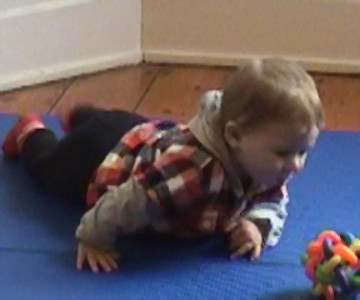
At 7 months typically developing babies can usually sit independently. Infants born preterm may sit a month or two later even using corrected age.
Once they have good balance in sitting their hands are free to pick up and manipulate interesting objects and at this age they become very interested, even obsessional about exploring what can be done with different toys.
Actions such as shaking, banging, throwing, and posting objects can be done with one hand.
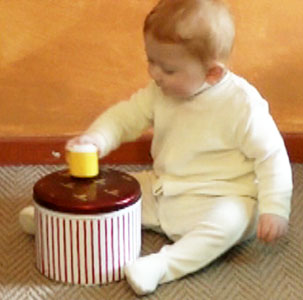

But many actions need two hands: catching a ball, picking up large toys, tipping a container upside down, pulling apart and putting together.


Read more: Guide to observing your baby 7-15 months
What to do if you notice that your infant is not using one hand well
If you are concerned that your baby is not using one hand as much as the other, it is a good idea to ask your baby's health care provider to take a careful look at the next clinic visit. Ask for a referral to an occupational or physical therapist for an assessment. Doctors often take a "wait and see" approach to developmental delay which is a pity because research shows that early intervention is the best way to overcome the movement difficulties that babies experience if brain development has been disturbed in any way. In fact it is a matter of the earlier the better. (See Early intervention after perinatal stroke: opportunities and challenges.)
In the meantime
While you are waiting for an appointment to see a physical or occupational therapist, or if you do not have access to these services, you can start to promote your babies hand function by providing them with many different opportunities to use their hands separately or together.
Activities for training baby hands 0-7 months
Bibliography
Novak, I., Morgan et al , N. (2017). Early, Accurate Diagnosis and Early Intervention in Cerebral Palsy: Advances in Diagnosis and Treatment. JAMA pediatrics, 171(9), 897–907. Full text
McIntyre S, Morgan C,Walker K, Novak I. Cerebral palsy –don’t delay.(2011) Developmental Disabilities Research Reviews. 17(2): 114-129.
Basu A. P. (2014). Early intervention after perinatal stroke: opportunities and challenges. Developmental medicine and child neurology, 56(6), 516-21.
Hoare B, Greaves S. (2017) Unimanual versus bimanual therapy in children with unilateral cerebral palsy: Same, same, but different. J Pediatr Rehabil Med. 2017;10(1):47-59.
Greaves S, Imms C, Krumlinde-Sundholm L, Dodd K, Eliasson AC. (2012) Bimanual behaviours in children aged 8-18 months: a literature review to select toys that elicit the use of two hands. Res Dev Disabil. Jan-Feb;33(1):240-50.
